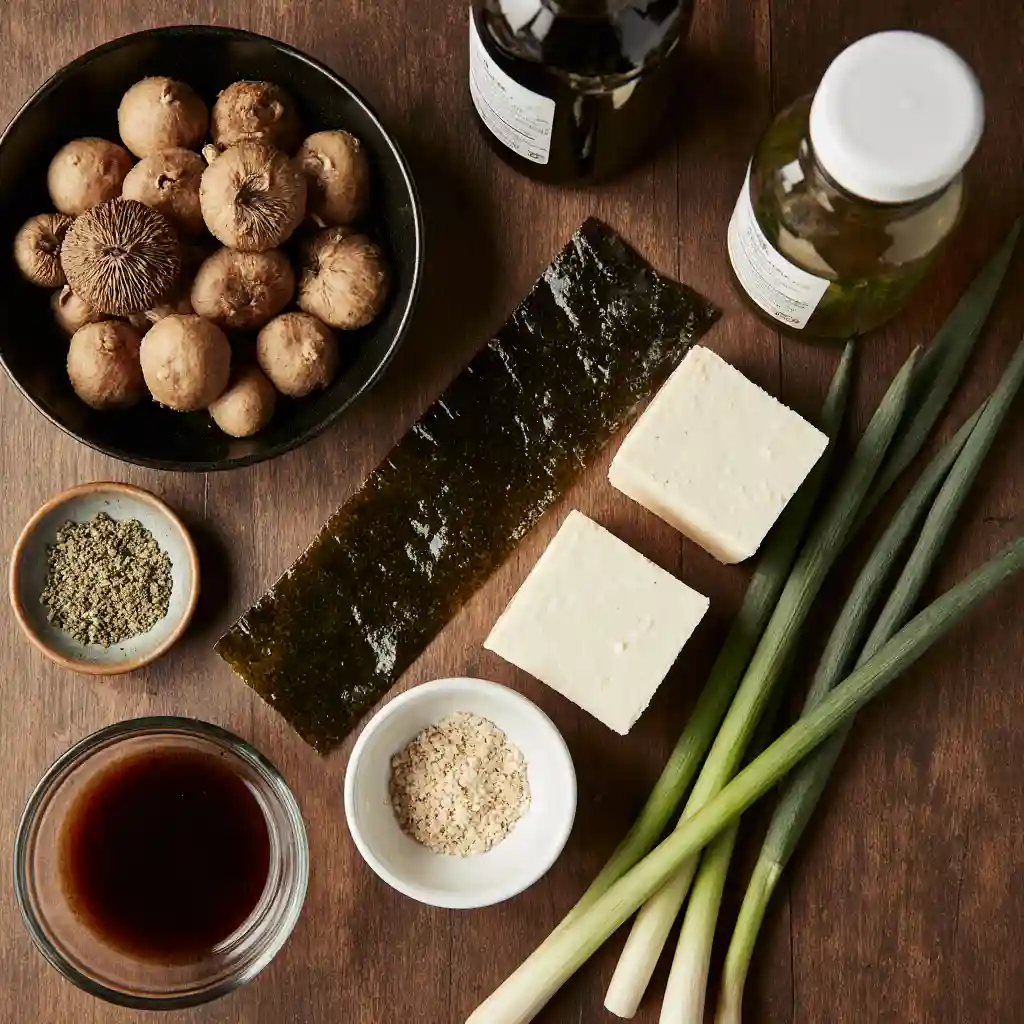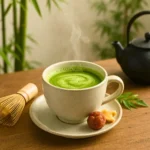By Chef Luna, World-Class Culinary Expert
Japanese clear soup recipe is a delightful, simple dish that can quickly become a favorite in any home. As a world-class chef with years of experience in international cuisines, I can tell you that the perfect clear soup Japanese is not just about the ingredients it’s about technique and balance. If you’ve ever craved the light and aromatic flavors of Japanese clear soup, this recipe is for you.
today’s, I’ll guide you through the essential steps to make the best clear Japanese soup recipe you’ve ever tasted. Plus, I’ll share helpful tips, the health benefits, and even a little personal story from my culinary journey that will make you appreciate this dish even more.
How to Make Japanese Clear Soup Recipe
Creating a perfect Japanese clear soup recipe is simpler than it may seem, and once you get the hang of it, you’ll be making this comforting dish regularly. Here’s how you can easily prepare clear soup Japanese with a few basic ingredients and steps:

Japanese Clear Soup
Ingredients
Equipment
Method
- Prepare the dashi by soaking the kombu in cold water for 30 minutes. Heat slowly until it begins to boil, then remove the kombu and add the katsuobushi. Simmer for 5 minutes and strain.
- Season the dashi with soy sauce and salt, adjusting to taste.
- Add the shiitake mushrooms, kamaboko, and fu (optional) to the dashi and simmer for 2-3 minutes.
- Pour the soup into serving bowls and garnish with fresh mitsuba leaves before serving.
Notes
What You’ll Need:
- Dashi: The soul of Japanese clear soup, made from kombu (seaweed) and bonito flakes (dried fish).
- Mushrooms: Shiitake or enoki mushrooms add earthy flavor and texture.
- Tofu: Soft, silken tofu gives the broth a creamy richness.
- Soy Sauce: For seasoning and deepening the broth’s umami flavor.
- Spring Onions: For garnish and a fresh, mild bite.
Step-by-Step Guide:
- Prepare the Dashi (Japanese Stock):
- Begin by placing a strip of kombu (dried seaweed) in a pot of cold water and letting it soak for about 30 minutes.
- Slowly heat the water with kombu over medium heat until it’s almost boiling, then remove the kombu.
- Add bonito flakes (dried fish flakes) to the water and let it simmer for about 5 minutes. Strain the stock to remove the bonito flakes, leaving behind the rich, clear broth.
- Begin by placing a strip of kombu (dried seaweed) in a pot of cold water and letting it soak for about 30 minutes.
- Season the Broth:
- Once the dashi is ready, season it with a splash of soy sauce. You can add a little mirin (sweet rice wine) to balance the flavors, or salt to taste.
- The goal here is to create a broth that’s light but packed with umami.
- Once the dashi is ready, season it with a splash of soy sauce. You can add a little mirin (sweet rice wine) to balance the flavors, or salt to taste.
- Add Mushrooms and Tofu:
- Slice shiitake mushrooms or enoki mushrooms thinly and add them to the dashi. Let them cook for 2-3 minutes until tender.
- Gently add silken tofu cubes into the soup and simmer for another 2 minutes. The tofu will absorb the broth, creating a silky texture.
- Slice shiitake mushrooms or enoki mushrooms thinly and add them to the dashi. Let them cook for 2-3 minutes until tender.
- Finish with Fresh Garnishes:
- Chop spring onions finely and sprinkle them over the soup just before serving. Their freshness will elevate the entire dish and add a delightful contrast to the rich broth.
- Chop spring onions finely and sprinkle them over the soup just before serving. Their freshness will elevate the entire dish and add a delightful contrast to the rich broth.
Serving Suggestions:
Serve your clear Japanese soup recipe hot in small bowls as an appetizer or alongside other Japanese dishes like sushi or tempura. The beauty of this dish lies in its simplicity, allowing each ingredient to shine in the broth.
Table of Contents
What is Japanese Clear Soup?
Japanese clear soup (also known as suimono) is a traditional, light broth that plays a crucial role in Japanese cuisine. Unlike hearty, thick soups, Japanese clear soup is known for its simplicity and delicate flavors. It is typically served as an appetizer or as part of a multi-course meal, acting as a refreshing, clean-tasting starter.
The essence of this soup lies in its clear broth, which is made from dashi a savory stock formed by simmering seaweed (kombu) and dried fish flakes (bonito flakes). The result is a clean, umami-rich liquid that serves as the foundation of Japanese clear soup.
This soup is prized for its subtlety. It highlights the natural flavors of the ingredients, and its beauty is in its purity. The use of shiitake mushrooms, tofu, and spring onions as common additions complements the broth without overwhelming the senses, offering a light yet satisfying experience.
Whether you’re enjoying it in a restaurant or preparing it at home, Japanese clear soup is all about embracing simplicity and balance. It’s the perfect dish when you want something clean, nourishing, and comforting.
What Are the Main Ingredients?
To make an authentic Japanese clear soup recipe, there are a few essential ingredients that come together to create the perfect balance of flavors. While the recipe may vary slightly depending on the region or personal preferences, the main components remain the same. Here’s a breakdown of the clear soup Japanese ingredients you’ll need:
1. Dashi (Japanese Stock)
The foundation of Japanese clear soup is dashi, a clear broth made from kombu (seaweed) and bonito flakes (dried fish). This stock is known for its rich, umami flavor, which is light yet deep and full of savory goodness. Dashi is the soul of the soup, infusing every ingredient with its subtle complexity.
2. Mushrooms
Shiitake mushrooms are the most commonly used variety in Japanese clear soup. These mushrooms add an earthy, umami-packed flavor that complements the delicate broth. You can also use enoki mushrooms for a milder, slightly sweeter flavor. Either way, the mushrooms provide a perfect texture and enhance the depth of the soup.
3. Tofu
Tofu, especially silken tofu, is added for its soft, creamy texture. It absorbs the dashi perfectly, creating a satisfying contrast to the clear broth. Tofu is a healthy source of protein and provides a subtle richness without overpowering the soup.
4. Soy Sauce
A splash of soy sauce is added to the broth to deepen the umami flavor and add a touch of saltiness. It helps balance the sweetness of the dashi and enhances the overall flavor profile.
5. Spring Onions
Spring onions (or scallions) are typically used as a garnish. They offer a burst of freshness and a slight sharpness that contrasts with the savory elements of the broth. Chopped finely, they add color and flavor, brightening up the entire dish.
These core ingredients combine to create the delicious, clean taste that defines clear Japanese soup recipe. The beauty of this soup lies in its simplicity each ingredient plays a role in bringing out the natural flavors, ensuring a light yet satisfying experience.
How Is It Prepared?
Preparing Japanese clear soup is simpler than you might think. With the right ingredients and a few basic steps, you can create a light, flavorful, and aromatic soup that captures the essence of Japanese cuisine. Follow these easy instructions to make a delicious clear soup Japanese recipe.
Step 1: Prepare the Dashi (Japanese Stock)
- Soak the Kombu: Start by placing a strip of kombu (dried seaweed) into a pot of cold water. Let it soak for about 30 minutes to release the natural umami flavor.
- Heat the Water: Slowly bring the water with kombu to a near-boil over medium heat. Be sure to remove the kombu just before it starts boiling to prevent it from becoming too bitter.
- Add Bonito Flakes: Add bonito flakes (dried fish flakes) to the pot and let it simmer for 5-10 minutes. Once the flakes sink to the bottom, strain the broth to remove the solids, leaving behind a clear and flavorful stock.
Step 2: Season the Broth
- Once your dashi is ready, season it with a splash of soy sauce. Depending on your taste, you can add a little mirin (sweet rice wine) or salt to enhance the flavors. This step is crucial to achieving the depth of umami that defines Japanese clear soup.
Step 3: Add Mushrooms and Tofu
- Slice your shiitake mushrooms or enoki mushrooms thinly and gently add them to the hot broth. Let them cook for 2-3 minutes until they soften and release their earthy flavors into the soup.
- Next, carefully add silken tofu cubes to the broth. Let them simmer for another 2 minutes, allowing the tofu to absorb the savory broth while maintaining its delicate texture.
Step 4: Garnish and Serve
- Once the mushrooms and tofu are perfectly cooked, ladle the soup into serving bowls.
- Finish by sprinkling finely sliced spring onions on top of the soup. Their fresh, sharp taste provides a delightful contrast to the rich, savory broth and adds a touch of color.
Step 5: Enjoy Your Clear Soup Japanese
Your clear Japanese soup recipe is now ready to serve! This soup can be enjoyed on its own as a light, refreshing starter or paired with sushi or tempura for a more substantial meal.
What Are the Health Benefits?
Not only is Japanese clear soup a delicious, comforting dish, but it also offers numerous health benefits. The light yet nutrient-rich ingredients provide a variety of positive effects on the body, making it a great addition to any balanced diet. Let’s dive into the health benefits of this flavorful soup:
1. Rich in Umami (Amino Acids)
The base of Japanese clear soup is dashi, a stock made from kombu (seaweed) and bonito flakes (dried fish). Both of these ingredients are rich in umami, the fifth taste sensation that enhances flavor and promotes a feeling of fullness. Umami is associated with the presence of amino acids, such as glutamate, which are known to aid in digestion and improve overall metabolism.
2. Supports Immune Health
Mushrooms, particularly shiitake and enoki, are packed with antioxidants and polysaccharides, compounds that support the immune system. These mushrooms help stimulate the production of immune cells, making Japanese clear soup a great food to incorporate into your diet for immune support.
3. Low in Calories, High in Nutrients
Unlike many hearty soups, clear Japanese soup is naturally low in calories, making it a great option for those looking to maintain or lose weight. It’s packed with essential vitamins and minerals from ingredients like tofu (which provides protein and calcium) and spring onions (which offer vitamin C and fiber). This makes it a satisfying, nutrient-dense choice without the heavy caloric load.
4. Promotes Healthy Digestion
The kombu used in the dashi is rich in fiber and iodine, both of which are beneficial for digestive health. Iodine is essential for healthy thyroid function, while fiber promotes healthy digestion and regular bowel movements. Consuming Japanese clear soup regularly can help support a healthy digestive system.
5. Hydrating and Detoxifying
Because the soup is made primarily from broth, it helps with hydration, which is essential for overall health. Additionally, the natural compounds in the kombu and mushrooms have detoxifying properties, helping the body to eliminate waste more efficiently. Staying hydrated while enjoying the light, flavorful soup makes it a great choice for both cleansing and maintaining balance in the body.
6. Stress-Reducing and Relaxing
The simplicity and warmth of Japanese clear soup can help promote relaxation and reduce stress. The act of eating a warm, soothing soup can help calm your mind and body. Plus, the amino acids in the broth can support mental clarity and reduce anxiety.
Japanese clear soup is not only delicious but also offers a wealth of health benefits, from immune support to promoting digestive health and relaxation. The combination of dashi, mushrooms, tofu, and spring onions makes for a well-rounded, nutritious dish that can help improve your overall well-being. Whether you’re looking for a healthy appetizer, a light meal, or a comforting food choice, clear Japanese soup recipe is a perfect option.
What Are the Regional and Cultural Variations
While Japanese clear soup is a simple dish at its core, there are many regional and cultural variations that reflect the diversity of Japanese cuisine. From the seasoning to the type of ingredients used, different areas of Japan put their own unique spin on this traditional soup. Here’s a look at some of the most notable variations:
1. Kyoto: Sweet and Delicate
In Kyoto, the heart of traditional Japanese culture, Japanese clear soup often has a slightly sweeter taste compared to other regions. This variation is made with a base of sweet dashi, using kombu and bonito flakes, but also incorporating a touch of mirin (sweet rice wine) to balance the savory flavors. The soup in Kyoto tends to feature a more delicate flavor profile and is often paired with yudofu (tofu hot pot) for a lighter meal.
2. Osaka: Flavorful and Bold
In Osaka, the soup is often enriched with a more robust flavor. Clear soup Japanese in this region may include added tempura flakes for a crispy texture or seafood such as shrimp, clams, or fish. The broth might be slightly stronger in flavor, with a more pronounced use of soy sauce or salt to give it a richer taste. Osaka’s version is known for its hearty nature, making it perfect as a main dish alongside sushi or other specialties.
3. Hokkaido: Hearty and Warming
Up in Hokkaido, the northernmost island of Japan, the winters are long and cold, so Japanese clear soup tends to be heartier and warming. The base often includes miso (fermented soybean paste) or a richer seafood dashi, which imparts a deeper umami flavor. This version of the soup may also include seasonal ingredients like crab or salmon, adding both flavor and protein to help keep you full and energized.
4. Tokyo: Light and Clean
In Tokyo, the capital city known for its modern approach to cuisine, Japanese clear soup tends to stick to a minimalist style. The focus is on creating a clean, light broth with subtle flavors. The soup may contain shiitake mushrooms, tofu, and spring onions, all simmered in a basic dashi. There’s often less emphasis on rich seasonings or additions, letting the natural flavors of the ingredients shine through. This version is often served as an appetizer in a kaiseki (traditional multi-course meal).
5. Shizuoka: Fresh and Ocean-Inspired
In Shizuoka, a region known for its access to fresh seafood, Japanese clear soup may feature an array of fish and shellfish. The soup is made with a more seafood-focused dashi, and ingredients like clams, squid, or sea bream are added for a unique ocean-inspired flavor. The light broth is perfect for bringing out the delicate sweetness of the seafood, making it a refreshing choice for summer or coastal cuisine.
6. Okinawa: Tropical and Refreshing
In Okinawa, known for its unique culture and tropical climate, Japanese clear soup may incorporate local ingredients such as seaweed and taro. The soup here is often lighter, with a fresher taste due to the tropical herbs and vegetables used in the broth. Okinawan clear soup might also feature local fish, like mackerel, for added richness and flavor.
Cultural Significance of Japanese Clear Soup

Across Japan, Japanese clear soup isn’t just a dish it’s part of the country’s food culture and tradition. Often served as part of a formal meal, the soup is a symbol of simplicity, purity, and respect for ingredients. It’s commonly found in ceremonies and family gatherings, representing harmony and balance in food.
The soup’s delicate flavors are meant to cleanse the palate and prepare the diner for the main courses that follow. It’s also seen as a healthy choice, as the light broth promotes digestion and provides a sense of well-being, making it a beloved staple in many households and restaurants.
How Is It Typically Served
Japanese clear soup is a versatile and elegant dish, and its presentation is just as important as its taste. Typically served as an appetizer or part of a multi-course meal, this soup’s delicate nature allows it to shine in various settings. Here’s how clear soup Japanese is typically served:
1. As an Appetizer in Multi-Course Meals (Kaiseki)
In formal kaiseki (traditional Japanese multi-course meals), Japanese clear soup is often served as an appetizer. It sets the tone for the meal, preparing the palate for the more complex dishes that follow. The soup is served in small, individual bowls to showcase the clean, clear broth and the simple elegance of the ingredients. The subtle flavors of the broth cleanse the taste buds, making it the perfect start to a sophisticated dining experience.
2. Accompanying Sushi or Tempura
Japanese clear soup is frequently served alongside sushi or tempura. The lightness of the soup complements the richness of sushi rolls and fried tempura, providing a balance of flavors. The broth helps cleanse the palate between bites of sushi or tempura, enhancing the overall dining experience. It’s a great way to transition between the different tastes of a Japanese meal.
3. In Japanese Home Cooking
In everyday Japanese home cooking, clear soup Japanese recipe is often enjoyed as a comforting bowl of soup for breakfast or dinner. It’s served hot and typically accompanied by a bowl of rice. This simple and light dish is perfect for a quiet, nourishing meal at home. In some homes, it’s served as a part of a set meal (teishoku), alongside pickles, rice, and grilled fish.
4. As a Side Dish for Special Occasions
On special occasions, like New Year’s Day or celebrations, clear Japanese soup can be served to honor tradition. For example, in osechi-ryori (traditional New Year’s cuisine), a type of Japanese clear soup known as osechi soup is served as part of the celebration, with variations depending on the region and family tradition.
5. In Informal Gatherings or Bento Boxes
In more casual settings, Japanese clear soup may be served in smaller portions as part of a bento box or a lunch set. It’s often served in a small, individual bowl alongside other dishes like rice, grilled fish, or vegetable side dishes. The soup’s simplicity makes it a perfect companion for other flavors, providing a refreshing contrast.
Presentation and Serving Tips
When serving Japanese clear soup, presentation is key. Here are a few tips to elevate your serving style:
- Small, Elegant Bowls: Japanese clear soup is typically served in small, lidded wooden or porcelain bowls. This adds a sense of tradition and elegance.
- Garnish: Garnish with finely chopped spring onions, shiso leaves, or even a small slice of lemon for an added touch of freshness.
- Serve Hot: The soup is best served hot, fresh from the pot, to enhance the comforting, soothing qualities of the broth.
Japanese clear soup can be enjoyed in various ways, whether as a sophisticated starter in a multi-course meal, as a side dish with sushi, or as a comforting bowl for casual meals at home. Its delicate flavors and simple presentation make it a beloved dish in Japan and around the world. No matter how you serve it, this soup remains a timeless part of Japanese cuisine, bringing warmth and balance to any meal.
Easy Japanese Clear Soup Recipe
Looking for a simple and quick way to make Japanese clear soup at home? Chef Luna’s easy Japanese clear soup recipe will have you enjoying this comforting dish in just 15 minutes! Perfect for busy weeknights or when you want to serve something healthy and flavorful with minimal effort.

Ingredients:
- 4 cups water
- 1 strip kombu (dried seaweed)
- 1/2 cup bonito flakes (dried fish)
- 1 tablespoon soy sauce (or more, to taste)
- 1 teaspoon mirin (optional, for a touch of sweetness)
- 1/2 cup shiitake mushrooms (thinly sliced)
- 1/2 block silken tofu (cut into cubes)
- 2 spring onions (finely chopped, for garnish)
- Salt, to taste
Instructions:
- Make the Dashi (Japanese Stock):
- In a medium-sized pot, place the kombu and water. Let it sit for 30 minutes.
- Bring the water to a gentle simmer over medium heat. Just before the water boils, remove the kombu.
- Add the bonito flakes and let them simmer for 5 minutes. Then, strain the broth to remove the flakes, leaving behind a clear, flavorful dashi.
- In a medium-sized pot, place the kombu and water. Let it sit for 30 minutes.
- Season the Broth:
- Add the soy sauce and mirin (if using) to the dashi, adjusting the seasoning to your taste. Add a pinch of salt if needed. Let it simmer for another 2 minutes.
- Add the soy sauce and mirin (if using) to the dashi, adjusting the seasoning to your taste. Add a pinch of salt if needed. Let it simmer for another 2 minutes.
- Add the Mushrooms and Tofu:
- Add the thinly sliced shiitake mushrooms to the broth. Simmer for about 2-3 minutes until the mushrooms soften.
- Gently add the tofu cubes to the soup. Let the tofu warm through for 1-2 minutes.
- Add the thinly sliced shiitake mushrooms to the broth. Simmer for about 2-3 minutes until the mushrooms soften.
- Garnish and Serve:
- Ladle the soup into individual bowls and garnish with freshly chopped spring onions.
- Serve hot, and enjoy the delicate, soothing flavors of your easy Japanese clear soup
- Ladle the soup into individual bowls and garnish with freshly chopped spring onions.
Tips for Customizing:
- You can add other vegetables like enoki mushrooms, spinach, or even bok choy for extra flavor and nutrition.
- If you prefer a stronger broth, you can simmer the kombu for longer or use a bit more soy sauce to increase the umami flavor.
- For a protein boost, consider adding shrimps or fish slices for a more filling version of the soup.
This easy Japanese clear soup recipe captures the simplicity and elegance of the dish while being quick and accessible. You can enjoy a bowl of this soup any time you’re in the mood for a light, healthy meal that’s packed with flavor. With just a few basic ingredients, you’re on your way to mastering this Japanese classic.
Best Japanese Clear Soup Recipe
When it comes to Japanese clear soup, the best version is one that strikes the perfect balance of flavors delicate, savory, and light. This best Japanese clear soup recipe brings out the natural umami of the ingredients, offering a clean broth that’s both satisfying and refreshing. Here’s how to make the ultimate clear soup Japanese that will impress your guests or elevate your everyday meals.
Ingredients:
- 4 cups water
- 1 strip kombu (dried seaweed)
- 1/2 cup bonito flakes (dried fish)
- 1 tablespoon soy sauce (use tamari for a gluten-free version)
- 1 teaspoon mirin (optional)
- 1/2 cup shiitake mushrooms (thinly sliced)
- 1/2 cup enoki mushrooms (optional, for texture and flavor)
- 1 block silken tofu (cut into cubes)
- 1 tablespoon sesame oil (for a hint of richness)
- 2 spring onions (finely chopped, for garnish)
- Salt and white pepper, to taste
Instructions:
- Prepare the Dashi (Japanese Stock):
- In a medium pot, combine kombu and water. Allow the kombu to soak in the water for 20-30 minutes.
- Heat the pot over medium heat and bring it to just below a boil. Remove the kombu just before the water begins to boil to prevent any bitterness.
- Add bonito flakes and let them simmer for 5-7 minutes. Once done, strain the liquid to remove the flakes, leaving behind a clean, umami-rich dashi.
- In a medium pot, combine kombu and water. Allow the kombu to soak in the water for 20-30 minutes.
- Season the Broth:
- Add soy sauce and mirin (if using) to the strained dashi. Season with a pinch of salt and a dash of white pepper. Stir well and bring the broth to a gentle simmer for 2-3 minutes.
- Add soy sauce and mirin (if using) to the strained dashi. Season with a pinch of salt and a dash of white pepper. Stir well and bring the broth to a gentle simmer for 2-3 minutes.
- Add the Mushrooms and Tofu:
- Add shiitake mushrooms (and enoki mushrooms, if using) to the simmering broth. Allow the mushrooms to soften and release their flavor into the broth for 3-4 minutes.
- Gently add silken tofu cubes into the broth and allow them to heat through for 2-3 minutes.
- Add shiitake mushrooms (and enoki mushrooms, if using) to the simmering broth. Allow the mushrooms to soften and release their flavor into the broth for 3-4 minutes.
- Finish with Sesame Oil and Garnish:
- Drizzle a small amount of sesame oil into the soup for added richness and a subtle depth of flavor.
- Ladle the soup into individual bowls and garnish with freshly chopped spring onions for a burst of color and freshness.
- Drizzle a small amount of sesame oil into the soup for added richness and a subtle depth of flavor.
- Serve and Enjoy:
- Serve the soup immediately while it’s hot. Pair it with sushi, tempura, or any of your favorite Japanese dishes for the best dining experience.
Why This Is the Best Japanese Clear Soup Recipe

This best Japanese clear soup recipe brings together all the elements that make clear soup Japanese so special: a clean, flavorful dashi broth, the richness of tofu, the earthy umami of mushrooms, and a subtle hint of sesame oil. The careful balance of ingredients makes this soup not only delicious but also satisfying, offering a perfect start to a Japanese meal.
Serving Tips:
- Serve this soup as part of a traditional kaiseki meal to experience the full spectrum of Japanese flavors.
- For a more filling meal, add shrimp, fish slices, or vegetables like bok choy or spinach.
- If you prefer a more intense broth, feel free to add a few more drops of soy sauce or a touch more mirin to enhance the flavor.
This best Japanese clear soup recipe is one you’ll come back to time and time again. It captures the essence of traditional Japanese cuisine with its clean, balanced flavors and simple, nourishing ingredients. Whether you’re enjoying it on its own or pairing it with other dishes, this soup is a comforting and elegant choice that will transport you straight to Japan with every spoonful.
Conclusion
Japanese clear soup is a delightful, light dish that perfectly balances simplicity with deep, savory flavors. Whether you’re making it for a special occasion or enjoying it as part of an everyday meal, this soup brings warmth, comfort, and nourishment to your table.
Through this guide, you’ve learned how to prepare the soup in various ways, from a quick and easy recipe to the best Japanese clear soup recipe, all while highlighting its health benefits, regional variations, and traditional significance in Japanese culture. With just a handful of ingredients, you can create a dish that’s not only delicious but also full of nutrition and flavor.
I hope this recipe has inspired you to experiment in the kitchen and try making your own Japanese clear soup recipe. Whether you prefer it simple or more robust, Chef Luna’s tips will help you create the perfect bowl of soup every time.
Thank you for joining me in exploring the world of Japanese cuisine. Keep cooking, keep experimenting, and don’t forget to share your experiences and thoughts in the comments below.
FAQs
Here are some frequently asked questions about Japanese clear soup. If you’re curious or have any doubts, I’ve got you covered with answers to help you make the perfect bowl of clear soup Japanese.
1. What is Japanese clear soup made of?
Japanese clear soup is made from a base of dashi, a stock made from kombu (seaweed) and bonito flakes (dried fish). The soup is typically flavored with soy sauce, mirin, and salt. Common additions include shiitake mushrooms, tofu, and spring onions for garnish.
2. Can you have Japanese clear soup before a colonoscopy?
Yes, Japanese clear soup is light and easy on the stomach, making it an excellent choice before a colonoscopy. It’s clear, low in fat, and easy to digest, which makes it suitable for a pre-procedural diet.
3. What are the ingredients of clear soup?
The key ingredients for clear soup Japanese include dashi (kombu and bonito flakes), soy sauce, mushrooms, tofu, and spring onions. The soup is simple but packed with flavor, offering a clean, light broth that’s easy to enjoy.
4. What is the difference between Japanese clear soup and miso soup?
The main difference lies in the base of the soup. Japanese clear soup is made with a light, transparent dashi broth, while miso soup is made with miso paste, a fermented soybean paste that gives the soup a thicker and more robust flavor. Both are staples in Japanese cuisine but offer distinct flavor profiles.
Addendum – Leave a Comment
I’d love to hear from you! Have you tried making Japanese clear soup? What are your thoughts on the recipe? Did you add your own twist or make any variations? Share your experiences, tips, or any questions you might have in the comments section below.
Your feedback means a lot to me, and I’m excited to see how you bring your personal touch to this dish. Don’t forget to visit my website for even more world-class recipes and culinary tips from Chef Luna’s Kitchen. From sushi to ramen, there’s always something new to discover.
Let’s keep the cooking conversation going. Feel free to subscribe to my site and get updates on new recipes, tips, and all things food. Together, we can continue to explore the rich flavors of Japanese cuisine and beyond.



